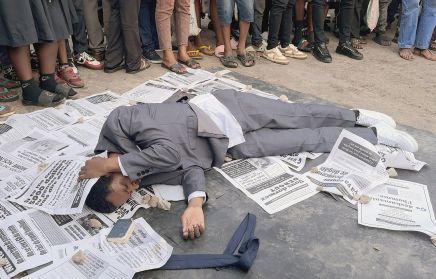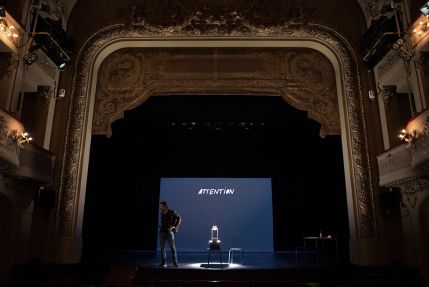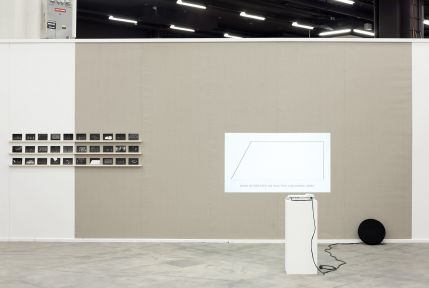The Conjurer: towards an ecology of attention
Alternating methods of criminal, artistic, political and social investigation, this inquiry focuses on "The Conjurer" by Hieronymous Bosch (or a disciple), a painting which surprisingly appears to anticipate the most contemporary forms of manipulation of collective attention.
Could this scene be used as a conceptual tool allowing us to (re)consider issues related to our own time? For several years, this question motivated the collection of numerous documents and testimonies, which today have led to a series of installations and lectures / performances.
The investigation thus follows the tracks of the various people and objects who shared the turbulent fate of this enigmatic artwork: used as a model for a series of political cartoons shortly after May '68, then stolen by one of the founders of the extreme left group Action Directe in 1979, the painting also appears to hold one of the most effectively concealed visual enigmas of its time. Furthermore, it offers the occasion to question, in dialogue with literary theoretician Yves Citton, the contemporary politics and economy of attention, and to contribute to the definition of a new "ecology of attention".
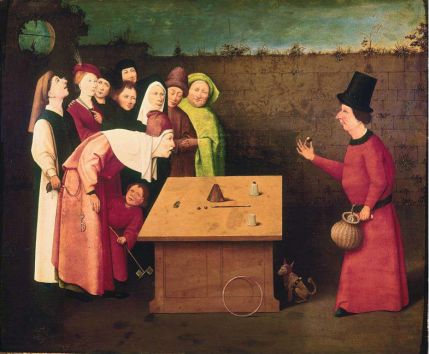
>
> projects: On balls and brains, Les Urbaines, Lausanne; Piano Nobile, Geneva; théâtre de Fontainebleau; FRAC Champagne-Ardenne, Reims; Black Mamba, Paris; Théâtre de l'Usine, Geneva; Musée MACVAL, Vitry-sur-Seine
> On balls and brains (installation)
> texts: L’Escamoteur: économie de l’illusion, écologie de l’attention
in Puissances de l’illusion, Presses universitaires de Grenoble
L’Escamoteur, ou le crime envisagé
in CCC Newsletter#10
What is interesting is not the image as a representation of reality, but its dynamic power, its ability to stir up and build projections, interactions and narrative frames structuring reality. What is interesting in the image is its ability to select among infinite possible perceptual experiences, so that imagination becomes imagin/action.
Franco Berardi (Bifo), The image dispositif
Un dispositif que ses victimes activent malgré elles, c’est cela la définition d’un système sorcier!
I.Stengers et P.Pignarre, La sorcellerie capitaliste
And in a corner –I assure you it was a dark corner– I discovered the painting. It was very strange because the impact of finding it, I don't know, it made my ear ring. It was a physical sensation. It's a really impressive painting, quite large, in cinemascope format. And it has an intensity of color, from that first vision I remember a metallic blue color, I don't even know if it exists in the painting. It left me with this impression of a very intense blue. It's really an extraordinary painting. It's a kind of relief, a juxtaposition of characters and colors, medieval dresses that are all in one vibrant color. You've got browns, ochres, reds, you've got the characters' headdresses. No, really, discovering the painting is an intense moment.
Extract from an interview with Jean-Marc Rouillan, describing the robbery of the painting in 1979

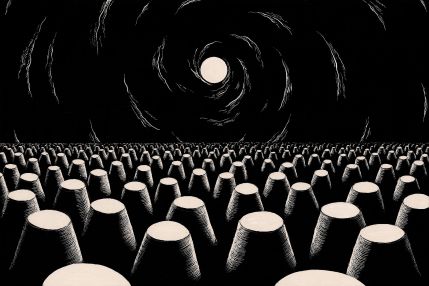
Attention is like water. It flows. It’s liquid. You create channels to divert it, and you hope that it flows the right way.
Apollo Robbins, pickpocket
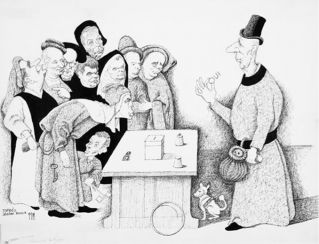
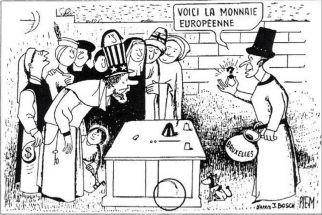
The Conjurer, an exemplary model to grasp the manipulation of collective attention. Less than a year after May 68, cartoonist Tim used it to comment on the political crisis shaking France. A few years later, fellow artist Piem used it to depict the creation of the European currency as a form of economic sleight of hand.
Based on this collection of testimonies over several years, the investigation first led to a series of lecture-performances presented in art centers, theaters and festivals from 2013 onwards. The central element of the device is a simple overhead projector, allowing to retrace the diagrams of the street scammers and the analysis of Bosch's painting, while alternating investigative narrative and theoretical questioning on the commodification of our attention.
In 2016, the project was presented in an installation in Basel. Featuring a montage of sound extracts whose subtitles were projected onto a canvas, as well as a selection of drawings on scratch cards, the installation earned the artist a Swiss Art Award.
Following these developments, the investigation was extended to the Democratic Republic of Congo, with a collection of local accounts of experiences of "escamotage" and manipulation. What captures, directs or diverts our attention? What appears and what disappears in our everyday environment? What forces organize these movements, and for what purpose?
Invited by the 9th Lubumbashi Biennale in 2017, researches were conducted in the mining region of Katanga with David Douglas Masamuna and Blaise Musaka, leading to the creation of an installation with posters, a sound piece and performances.
The investigation was pursued in Kinshasa, again with Blaise Musaka, as part of the 2022 Yango Biennale. The collection of local stories led to a street installation and performance, in collaboration with Michael Disanka, Christiana Tabaro and their collective D'Art-D'Art.

